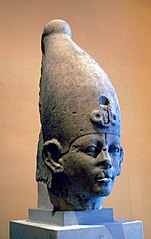Sobekhotep I
| ||
 Sobekhotep I (dawniej Sobekhotep II) | ||
| władca starożytnego Egiptu | ||
| Poprzednik | Amenemhat IV ? | |
| Następca | Amenemhat V Chendżer ? | |
| Dane biograficzne | ||
| Dynastia | XIII dynastia | |
| Ojciec | Amenemhat IV ? | |
| Matka | Neferusobek ? | |
Sekhemre Khutawy Sobekhotep I (w starszych opracowaniach Sobekhotep II) − władca starożytnego Egiptu, XIII dynastii w czasie Drugiego Okresu Przejściowego. Znany z inskrypcji na kilku monumentach,w tym statuy z czerwonego granitu, znajdującej się obecnie w Muzeum Brytyjskim i z budynków w Luksorze. Był prawdopodobnie synem Amenemhata IV i Neferusobek. Rządził około trzech lat.
Bibliografia
- Darrell D. Baker: The Encyclopedia of the Pharaohs. T. I: Predynastic to the Twentieth Dynasty 3300–1069 BC. London: Stacey International, 2008. ISBN 978-1-905299-37-9.
- Nicolas Grimal: A History of Ancient Egypt. Oxford, UK / Cambridge, USA: Blacwell Publishers, 1994. ISBN 0-631-17472-9. (ang.)
- Bogusław Kwiatkowski: Poczet faraonów: życie, legenda, odkrycia. Warszawa: Iskry, 2002. ISBN 83-207-1677-2.
| |||||||||||||||||||||||||||||||||||||||||||||||||||||||||||||||||||||||||||||||||||||||||||||||||||||||||||||||||||||||||||||||||||||||||||||||||||||||||||||||||||||||||||||||||||||
Media użyte na tej stronie
Autor: Juan R. Lazaro, Licencja: CC BY 2.0
Head of a colossus Osirian king-khutawy Sekhemre Sebekhotep I (?).
• Dynasty XIII. Reign of Sekhemre-khutawy Sebekhotep I (?). • Hometown: Medamud. Excavations Bisson de la Roque. Donated by Egypt in 1927, in the distribution of findings. • Material: Limestone. • Dimensions: Height 86.8 cm, width 32.7 cm. • Conservation: Paris. Louvre, E 12924.
The identification of the sovereign here represented, is still disputed:
Gilbert and Altenmüller, thought they saw here the image of King Amenemhat III.
Bisson de la Roque, Corteggiani, Davies, Nelson and Vandier, head of the Louvre identified this as the image of a ruler of Dynasty XIII. Probably the king Sekhemre-khutawy Sebekhotep I, which is found in Medamud certain architectural elements, or perhaps, the king Khutawire Wegaf.
Also the large number of statues of King Sensusert III found in Medamud, did think that this might have been equally head, a portrait of that king of the Twelfth Dynasty.Autor: Piotr Michał Jaworski; PioM EN DE PL, Licencja: CC-BY-SA-3.0
Pharaoh's insignia (staff, flail, and uraeus head-dress)


